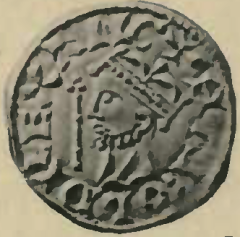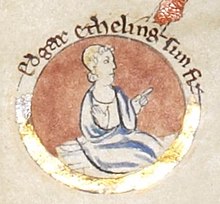England, having seen the raids, battles, and invasion from the Vikings for several centuries, now was briefly back in the hands of a saxon restoration, with Edward having been invited back to the throne. But a decisive point in English history was fast approaching as we approach closer to the battle that is perhaps the most famous in England, the Battle of Hastings, and as a result, this post is longer, for which I apologise.
| Edwards's Attributed Arms |
Edward's position as King, was weak and to rule effectively he needed to appease the three leading earls at that time (Leofric of Mercia, Godwin and Siward of Northumbria), but loyalty to the ancient house of Wessex was no more as this had been eroded by the period of Danish rule, and only Leofric was descended from a family which had served Æthelred. Siward was probably Danish, and although Godwin was English, he was one of Cnut's new men, married to Cnut's former sister-in-law.
 |
| Edward |
Edward, despite having the greatest of wealth, landwise, over the other Earls, showed no interest in solidifying his powerbase, as they were situated in the Earldoms in southern England.
Meanwhile, King Magnus of Norway aspired to the English throne, and in 1045 and 1046, fearing an invasion, Edward took command of the fleet at Sandwich. Beorn's elder brother, Sweyn of Denmark had become as a son to Edward, hoping for his help in his battle with Magnus for control of Denmark, however Edward rejected Godwin's demand in 1047, that he send aid to Sweyn, and it was only upon Magnus's death in October that saved England from attack and allowed Sweyn to take the Danish throne.
Edward was canonized in 1161 by Pope Alexander III, and is commemorated on 13 October by the Catholic Church of England and Wales and the Church of England. He was regarded as one of the national saints of England until King Edward III adopted Saint George as patron saint in about 1350.
 |
| Penny depicting Harold |
When
Harold’s father, Godwin, died in 1053, he became Earl of Wessex, and as the
province covered the southernmost third of England, was the most powerful
figure in England after the King. He
also became Earl of Hereford in 1058, and continued his father’s stance in
opposing the increasing Norman influence in England during Edward the Confessor’s
reign.
Having
been shipwrecked in Ponthieu in 1064, Harold was captured and held hostage by
Count Guy I of Ponthieu at his castle at Beaurain. Duke William arrived soon after and order
Harold be turned over to him. Harold
then accompanied William to battle against William’s enemy, the Duke of
Brittany and won. Harold was awarded with weapons and arms and knighted
him. The famous Bayeux Tapastry shows Harold
swearing an oath, on sacred relics, to support William’s claim to the crown of
England.
 |
| Harold |
In 1065,
King Edward fell into a coma without signifying an heir, and whilst he breifly regained
consciousness, he ambiguously commended his widow and the kingdom to Harold’s
protection, and died on 5 January 1066. The
Witenagemot however, met the following day and selected Harold to succeed and
was crowned the same day.
Harold,
upon hearing that Duke William of Normandy was amassing an invasion force, assembled
his troops on the Isle of Wright, but disbanded them after eight months of
waiting with provisions running out, and returned to London on 8 September
1066.
On that
very same day, Tostig was joined by Harald Hardrada and invaded landing his
fleet at the mouth of the River Tyne.
They defeated Edwin of Mercia, and Morcar of Northumbria at the Battle
of Fulford, near York on 20 September, but were taken by surprise five days
later at the Battle of Stamford Bridge where Harold had force marched his men
for four days from London.
| Spot where Harold Died |
The spot where Harold died is now the site of Battle Abbey.
Edgar the Ætheling 1066: Edgar
was born in Hungary and was the only son of Edward the Exile (King Edmund II
Ironside) and Agatha.
 |
| Edgar |
King Edward
(the Confessor) summoned Edward the Exile back to England on hearing that he
was still alive, but died two days after arriving, having been most likely
murdered. Edgar, 6 at the time, was the only last surviving male member of the
royal dynasty apart from the King.
Upon
King Edwards death, Edgar (in his teens) was considered to be too young to be
an effective military leader, and due to the King’s failure to announce an
heir, war was inevitable, and so Harold was appointed by the Witenagemot as
best placed to become King and defend the country.
However,
following Harold death at Hastings, the Witenagemot convened in London and
elected Edgar King. The regime which was established was dominated by the most
powerful surviving members of the English ruling class, however their commitment
to the cause was doubtful at best, as
most were overlooked to be King, and William’s victory over Harold challenged
their resolve to continue the struggle.
As the
Normans closed in on London, the remaining Witenagemot members met in December
and resolved to take the uncrowned King to meet William and to submit him at
Berkamstead.
The crowning
of King William I (the Conqueror), on 25 December 1066, ushers in the Normandy
era.
And it
is from the reign of William, that he and his descendants took regnal numbers
to distinguish monarchs as opposed to nicknames, although this custom did not
die out totally.
No comments:
Post a Comment